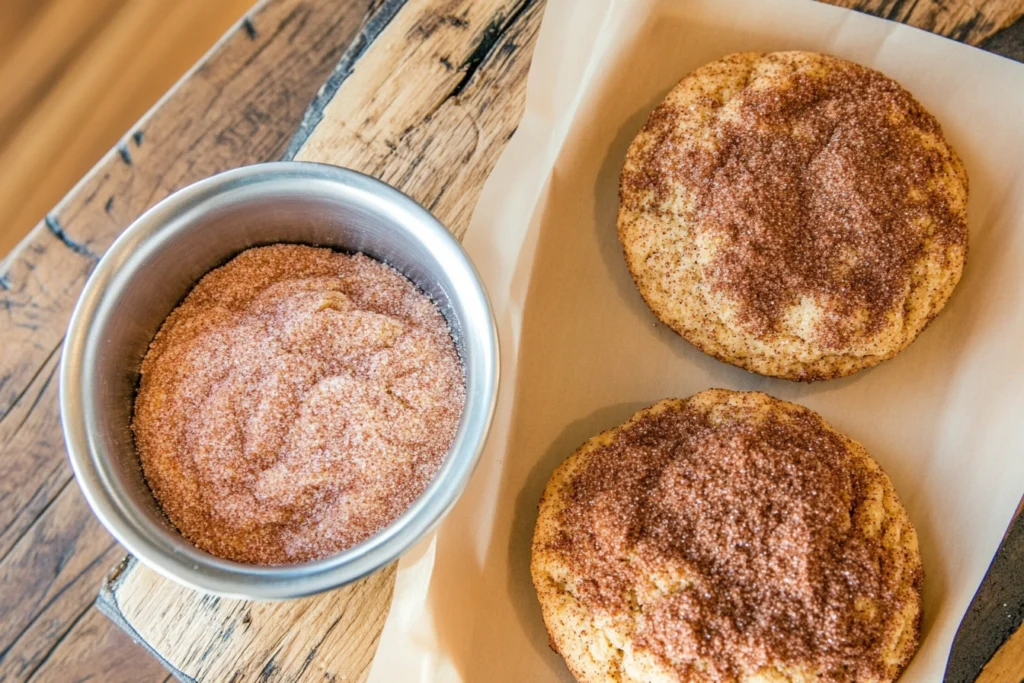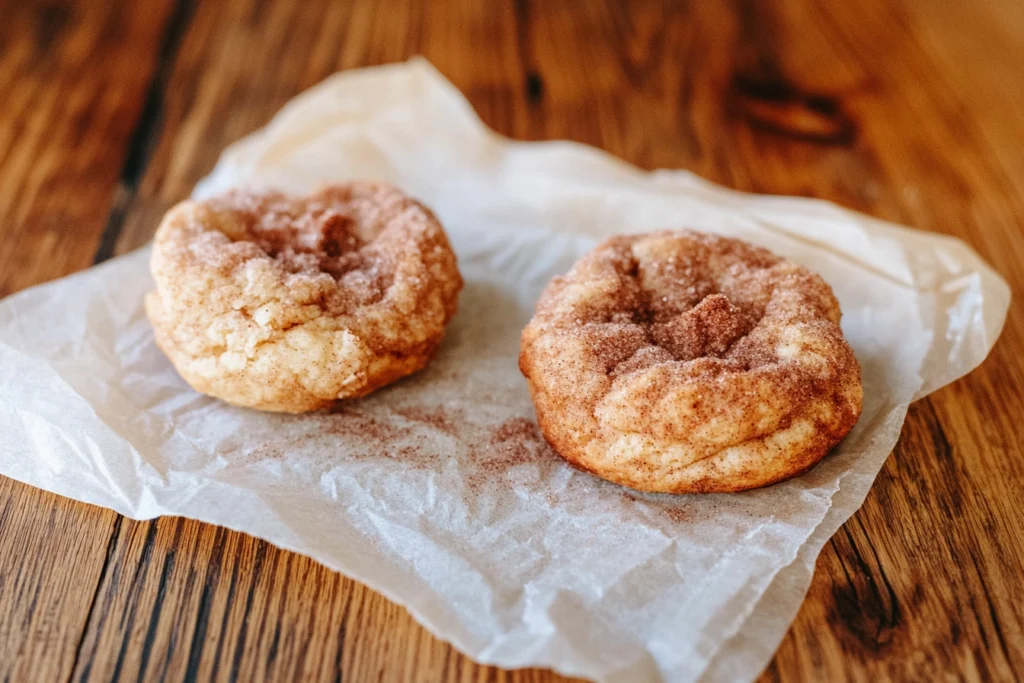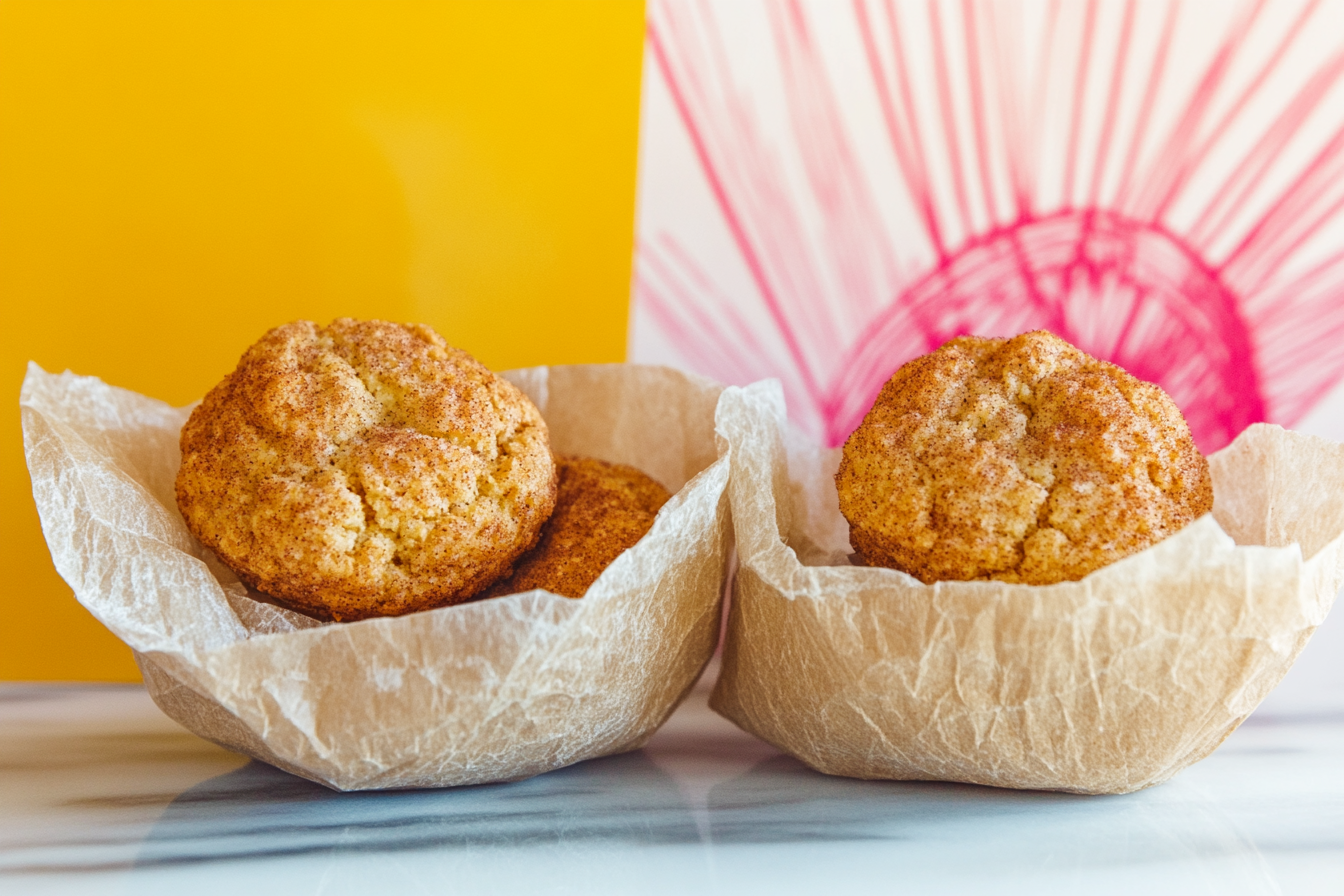Part 1
1. Introduction to Snickerdoodles
Snickerdoodles, the beloved cinnamon-sugar-coated cookies, are a timeless treat with a signature tangy flavor and soft, chewy texture. These cookies have been a favorite in bakeries and home kitchens for decades, and their charm lies in their simplicity. The classic recipe uses basic pantry staples like sugar, flour, butter, eggs, and an essential leavening agent.
Baking Without Cream of Tartar may seem challenging since it’s a key ingredient that gives snickerdoodles their traditional tang. However, there are excellent substitutes, such as baking powder or a combination of lemon juice and baking soda, that can achieve a similar texture and taste. Whether you’re out of cream of tartar or prefer a different approach, you can still master the art of making perfect snickerdoodles!
2. Understanding Cream of Tartar
Cream of tartar, or potassium bitartrate, is a natural byproduct of winemaking. It appears as a white, powdery substance that serves as a powerful acid in baking. Here’s why it’s a baking staple:
- Stabilizing Egg Whites: It’s often used to maintain the structure of whipped egg whites, making it invaluable for meringues and soufflés.
- Preventing Crystallization: Cream of tartar prevents sugar from crystallizing, contributing to the smooth texture of syrups and frostings.
- Leavening Agent: When combined with baking soda, it acts as a leavening agent, creating carbon dioxide bubbles that help baked goods rise.
In snickerdoodles, cream of tartar not only lends its tangy flavor but also plays a crucial role in their soft, chewy texture.

3. The Science Behind Snickerdoodles
The magic of snickerdoodles lies in their chemistry. When baking soda and cream of tartar come together, a chemical reaction occurs:
- The acidic cream of tartar activates the baking soda, creating carbon dioxide bubbles that cause the cookies to puff up in the oven.
- Without cream of tartar, this reaction is altered, potentially affecting both the texture and flavor of the final product.
This interplay ensures that snickerdoodles remain soft and airy, with a subtle rise that enhances their chewiness.
4. Flavor Changes Without Cream of Tartar
Omitting cream of tartar can significantly change the flavor profile of snickerdoodles:
- Classic Tang: The tanginess that defines traditional snickerdoodles comes from the acidity of cream of tartar. Without it, the cookies may taste sweeter but lack the signature zing.
- Flavor Comparison: Without cream of tartar, snickerdoodles might resemble sugar cookies with a cinnamon twist. While still delicious, they may lose their distinctive identity.
If you’re looking to recreate the tangy flavor without cream of tartar, incorporating acidic substitutes like lemon juice or white vinegar can help.
5. Texture Differences Without Cream of Tartar
The absence of cream of tartar also impacts the iconic texture of snickerdoodles:
- Softer Cookies: Cream of tartar contributes to the soft, pillowy texture. Without it, the cookies may become denser or crispier, especially around the edges.
- Chewiness: The combination of cream of tartar and baking soda prevents over-spreading, giving snickerdoodles their characteristic chew. Without it, cookies might spread more, resulting in thinner, crunchier treats.
Understanding these changes can help you adjust your recipe to achieve the desired consistency.
6. Substituting Cream of Tartar
When you don’t have cream of tartar on hand, several substitutes can mimic its effects in baking. Each has its pros and cons:
- Lemon Juice: Offers the acidity needed for leavening but may add a slight citrus flavor.
- Ratio: Use 1 teaspoon of lemon juice for every ½ teaspoon of cream of tartar.
- White Vinegar: A neutral-tasting substitute that works well in most recipes.
- Ratio: Use 1 teaspoon of vinegar for every ½ teaspoon of cream of tartar.
- Buttermilk: Adds tanginess and moisture, though it requires adjustments to the liquid content of the recipe.
- Ratio: Reduce other liquids slightly to compensate for the added buttermilk.
Experimenting with these substitutes can help you maintain the essence of snickerdoodles, even without cream of tartar.
7. Making Snickerdoodles Without Cream of Tartar
Adapting a snickerdoodle recipe without cream of tartar is simple if you follow these steps:
- Replace Cream of Tartar: Choose a substitute like lemon juice or vinegar, and adjust the quantity accordingly.
- Balance Ingredients: Since cream of tartar contributes acidity, ensure that the substitute pairs well with baking soda for effective leavening.
- Monitor Texture: Without cream of tartar, the dough might be stickier. Chill it for easier handling and better shape retention during baking.
- Adjust Baking Time: Keep an eye on the cookies as they bake; they may spread more and cook faster without cream of tartar.
This step-by-step approach ensures that your snickerdoodles remain delicious and true to their spirit.
8. Common Mistakes When Omitting Cream of Tartar
Baking without cream of tartar can be tricky. Avoid these common pitfalls:
- Overcompensating with Acid: Adding too much lemon juice or vinegar can overwhelm the flavor and ruin the balance of sweetness and tang.
- Skipping the Acid Altogether: Omitting cream of tartar without a substitute can result in flat, dense cookies.
- Neglecting Texture Adjustments: Without cream of tartar, snickerdoodles may require a slightly different handling or baking method to achieve the right texture.
By understanding these potential errors, you can confidently bake snickerdoodles without cream of tartar.
9. Alternative Recipe Variations
For those looking to get creative, explore variations that don’t rely on cream of tartar:
- Brown Sugar Snickerdoodles: Swap out some white sugar for brown sugar to enhance moisture and add a caramel-like depth of flavor.
- Cinnamon-Spiced Variations: Boost the cinnamon flavor by incorporating a dash of nutmeg or cardamom.
- Healthier Options: Use whole wheat flour or almond flour for a nuttier flavor and a slightly denser texture.
These alternatives allow you to experiment with flavors and ingredients while maintaining the core appeal of snickerdoodles.
10. FAQ About Cream of Tartar in Baking
- Can you leave out cream of tartar entirely?
- Yes, but expect changes in flavor and texture. Using a substitute is recommended.
- Does cream of tartar affect shelf life?
- Not significantly, though it can contribute to a slightly softer cookie over time.
- What’s the best substitute for cream of tartar?
- Lemon juice or white vinegar are the most effective.
- Can I use baking powder instead?
- Yes, as it contains both acid and a base, but you may need to adjust the quantity.
- How does it impact rising?
- Without cream of tartar, cookies may rise less and spread more.
- Is cream of tartar gluten-free?
- Yes, it’s naturally gluten-free.
- Does it add a noticeable flavor?
- It adds a subtle tang, often associated with classic snickerdoodles.
- Can I make snickerdoodles vegan without cream of tartar?
- Yes, by using plant-based substitutes for other ingredients.
- Why do recipes call for both cream of tartar and baking soda?
- Together, they create the necessary chemical reaction for leavening.
- What other cookies use cream of tartar?
- It’s common in meringue cookies and sugar cookies.
Part 2: Exploring the Intricacies of Snickerdoodles Without Cream of Tartar
11. Comparing Baking Results: With vs. Without Cream of Tartar
Baking snickerdoodles with and without cream of tartar yields noticeable differences in texture, flavor, and appearance. Here’s a breakdown:
- Appearance:
- With Cream of Tartar: Cookies appear puffier with a slightly crackled surface.
- Without Cream of Tartar: The cookies tend to spread more and may have a smoother, flatter top.
- Texture:
- With Cream of Tartar: Soft and chewy, with a delicate crumb.
- Without Cream of Tartar: Slightly crisp edges with a denser center.
- Flavor:
- With Cream of Tartar: A tangy note that complements the sweetness and cinnamon.
- Without Cream of Tartar: The tanginess is subdued, leaning more toward a traditional sugar cookie flavor.
By observing these differences, you can decide which version best suits your taste and aesthetic preferences.
12. Tips for Beginners
Starting your journey of baking snickerdoodles without cream of tartar? Follow these tips to ensure success:
- Test Substitutes: Begin with common substitutes like lemon juice or vinegar in small quantities.
- Chill the Dough: Chilling helps control spreading, particularly when cream of tartar is absent.
- Use Fresh Baking Soda: Since cream of tartar activates baking soda, ensure your baking soda is fresh to achieve optimal leavening.
- Measure Accurately: Baking is a science. Use a kitchen scale for precise measurements.
- Watch the Oven: Without cream of tartar, baking times may differ slightly. Check cookies a minute or two earlier than the original recipe suggests.
With patience and practice, even beginner bakers can master the art of adapting recipes without cream of tartar.
13. Health Considerations of Cream of Tartar
Cream of tartar is generally safe, but here’s what you should know:
- Nutritional Benefits: It’s a source of potassium, though the amounts used in baking are minimal.
- Dietary Restrictions: Cream of tartar is naturally gluten-free and vegan, making it suitable for most diets.
- Potential Drawbacks: Consuming large quantities could upset potassium balance, but this is rarely a concern in normal baking usage.
If you’re following a specific diet, leaving out cream of tartar or substituting it can help tailor the recipe to your needs without significant nutritional compromise.
14. Cultural and Historical Context of Snickerdoodles
Snickerdoodles have a rich history, thought to originate in Germany or the Netherlands. Their name likely comes from the German word “Schneckennudeln,” meaning “snail noodles,” a reference to their coiled appearance in some early recipes.
- 19th Century Popularity: Snickerdoodles gained fame in American cookbooks in the late 1800s, particularly in New England.
- The Cream of Tartar Connection: Early American recipes began incorporating cream of tartar as it became widely available, adding a tangy twist and improving texture.
Understanding their origins deepens your appreciation for the unique charm of snickerdoodles.
15. Exploring the Role of Acidity in Baking
Acidity is a key player in baking, impacting everything from flavor to texture. Here’s how it works:
- Flavor Enhancement: Acids like cream of tartar brighten the flavor profile, balancing sweetness.
- Leavening Power: Acids react with bases (like baking soda) to create carbon dioxide, which helps baked goods rise.
- Texture Control: Acidity can alter the protein structure in doughs, contributing to tenderness.
When omitting cream of tartar, it’s crucial to replace its acidity with alternatives like lemon juice, vinegar, or buttermilk to maintain these effects.

16. Troubleshooting Common Issues Without Cream of Tartar
Baking snickerdoodles without cream of tartar can lead to challenges. Here’s how to address them:
- Flat Cookies: If cookies spread too much, chill the dough longer or add an extra tablespoon of flour.
- Dense Texture: To avoid density, ensure you’re using a proper acid substitute to activate baking soda.
- Imbalanced Flavor: If the tangy note is missing, consider adding a hint of lemon zest or increasing cinnamon for a flavor boost.
By fine-tuning your approach, you can overcome these hurdles and achieve bakery-quality cookies.
17. Baking Tools and Equipment Tips
Using the right tools can make a big difference in baking snickerdoodles. Here’s what you need:
- Stand Mixer: Ensures even mixing and creaminess in the dough.
- Silicone Baking Mats: Prevents sticking and promotes even baking.
- Cookie Scoops: Helps create uniform cookies for consistent results.
- Kitchen Scale: Guarantees precise measurements, especially when substituting ingredients.
- Cooling Racks: Keeps cookies from overbaking on the hot pan.
Investing in these tools ensures a smoother, more enjoyable baking process.
18. Flavor Pairings with Snickerdoodles
Snickerdoodles pair beautifully with a variety of flavors and accompaniments:
- Beverages:
- Serve with warm drinks like coffee, chai tea, or hot cocoa.
- Cold milk or eggnog are festive options during the holidays.
- Spices and Extracts:
- Add a pinch of nutmeg, cardamom, or allspice to the cinnamon-sugar coating.
- Experiment with vanilla, almond, or maple extracts for a unique twist.
Elevate your snickerdoodle experience by exploring these complementary pairings.
19. Snickerdoodle Recipe for Specific Diets
Adapting snickerdoodles for dietary preferences is easier than you think:
- Gluten-Free:
- Use a 1:1 gluten-free flour blend. Add xanthan gum if not included in the blend to improve texture.
- Vegan:
- Replace butter with coconut oil or vegan margarine.
- Use flaxseed meal mixed with water (flax eggs) instead of eggs.
- Keto-Friendly:
- Substitute sugar with erythritol or monk fruit sweetener.
- Use almond flour or coconut flour for a low-carb option.
These adjustments ensure everyone can enjoy the magic of snickerdoodles.
20. Fun Facts About Snickerdoodles
- Snickerdoodles have been around since the late 1800s.
- They’re often referred to as “sugar cookies with a cinnamon twist.”
- The name “snickerdoodle” has whimsical origins, likely inspired by playful German words.
- They’re a staple of Amish and Mennonite baking traditions.
- In the U.S., National Snickerdoodle Day is celebrated on October 1st.
- The tangy flavor comes from the cream of tartar, a unique addition compared to other cookies.
- Snickerdoodles are popular holiday cookies due to their warm, spicy flavors.
- Early recipes used lard instead of butter.
- They’re often baked for bake sales and community gatherings due to their simplicity.
- Despite their humble ingredients, snickerdoodles are considered a gourmet treat in some bakeries.
Part 3: Snickerdoodles Without Cream of Tartar – Final Insights
21. Experimenting with Texture and Flavor
Customizing snickerdoodles allows you to explore unique textures and flavors. Here’s how you can innovate:
- Adjusting Sugar Ratios: Adding more brown sugar enhances chewiness and adds a caramel-like depth, while more granulated sugar creates a crispier texture.
- Playing with the Coating: Incorporate spices like cardamom, nutmeg, or even chili powder into the cinnamon-sugar coating for a bold twist.
- Adding Mix-Ins: Experiment with chopped nuts, white chocolate chips, or dried fruits to create a gourmet version.
By tweaking these elements, you can develop a signature snickerdoodle recipe.
22. Storing Snickerdoodles Without Cream of Tartar
Proper storage ensures your cookies remain fresh and flavorful:
- Short-Term Storage: Place cookies in an airtight container at room temperature for up to a week.
- Long-Term Storage: Freeze baked cookies or dough balls for up to three months. For best results, flash-freeze dough balls on a tray before transferring them to a freezer bag.
- Reheating Tip: Revive stored cookies by microwaving for 10 seconds to restore their softness.
Keep your snickerdoodles delicious with these storage practices.
23. Feedback and Reviews of Modified Recipes
Home bakers who tried snickerdoodles without cream of tartar often note differences in flavor and texture:
- Positive Feedback:
- Many appreciate the simplicity of substitutes like lemon juice or vinegar.
- Some enjoy the less tangy, sugar-cookie-like flavor.
- Constructive Criticism:
- Flat cookies are a common complaint. Adjusting dough chill time and oven temperature can help.
- Subtle tanginess is often missed, inspiring bakers to experiment with other acidic ingredients.
These insights guide you toward refining your recipe for the best results.
24. Enhancing Presentation of Snickerdoodles
Elevate your snickerdoodles for parties or gifts with these ideas:
- Drizzle with Glaze: Add a simple vanilla or caramel drizzle for a decorative touch.
- Creative Shapes: Use cookie cutters to create holiday-themed shapes.
- Gift Packaging: Arrange cookies in festive tins or cellophane bags tied with ribbons for an elegant presentation.
Presentation can make your snickerdoodles even more special.
25. Wrapping Up: The Essence of Snickerdoodles
Snickerdoodles, with or without cream of tartar, embody the joy of baking. Their warm cinnamon-sugar coating, paired with a soft and chewy texture, makes them irresistible. Whether you stick to tradition or adapt the recipe to suit your pantry, these cookies remain a crowd-pleaser.
Celebrate the timeless appeal of snickerdoodles by experimenting, sharing, and savoring every bi

